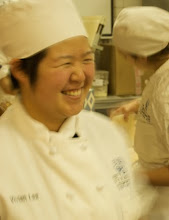I had a chance to visit my friends Catherine and Scott out on Long Island over the last few days. Upon arriving, Catherine and I decided to flex our baking muscles. What's more satisfying than homemade pizza dough?
We took Jamie Oliver's pizza dough recipe from his book titled "Jamie at Home" and made calzones for dinner. Most of the people that I know feel intimidated by the thought of making dough at home, but it really was pretty simple. The recipe we used made enough dough for 6-8 individual pizzas. At first I was determined to let the mixer do all of the work, but after a few minutes the smell of metal started to fill the air and I knew the mixer was heating up a bit too much. I decided to knead the dough by hand for a while. I worked it enough to where I was close in getting the right gluten structure (I used the window pane test) and left the dough to proof in a lightly oiled bowl covered with plastic.

Catherine, Scott, and I decided to go for a walk on the beach to search for some sea glass while we waited for the dough to rise. It was pretty windy and cold by the water's edge, but we did come away from the walk with some nice pieces of glass and some awesome pictures of the sunset.

After we got back from our break, full attention was given to the dough since our stomachs were pretty much all talking to us, as was the dough. The dough had doubled in size and definitely was ready to divide. I lightly floured the table surface and flipped the bowl so that gravity could help me remove the dough from the bowl.

At this point, I decided to just eye the divide and cut the dough into six pieces.

From there, we pre-shaped the dough round and bench rested for about 15 minutes. Next, we flattened the dough out into a disc and started to load our filling on the dough, making sure to place the ingredients on half of the disc. We also needed to leave room around the edge to make sure we'd be able to crimp the edges shut.

Catherine and I decided to use four of the six rounds of dough for calzones and save the other two to make pizza dough the next night. The fillings we decided on for the calzones included ricotta (mixed with an egg, fresh herbs, salt, and pepper), pepperoni, olives, spinach sauteed with garlic, roasted red peppers, and fresh mozzarella.

These calzones proved that there's something really satisfying about making pizza dough at home.


 Image was taken by John Lei for the NY Times.
Image was taken by John Lei for the NY Times.









